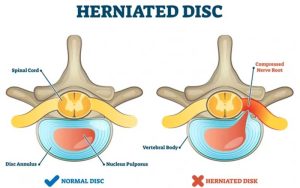5 Advanced Non-Surgical Methods for Treating Lumbar Discs in 2025

Introduction
Is persistent back pain disrupting your daily life? A herniated disc is one of the most common causes of back pain that can make simple activities like walking or sitting a challenge. The good news is that in 2025, there are advanced non-surgical methods for treating a herniated disc that will help you get back to your normal life without the need for a surgical blade. In this article, we will review the top 5 non-surgical methods for treating a herniated disc that are not only effective, but also backed by modern technologies and scientific approaches. If you are looking for a safe and effective solution, stay with Spanta Center until the end of this article!
Why is non-surgical lumbar disc treatment important?
Lumbar disc surgery may be necessary for some patients, but the risks, high costs, and long recovery period have led many to seek nonsurgical options. These methods typically include:
-
They are low-risk and safe.
-
They have a shorter recovery period.
-
They cost less than surgery.
-
They help improve quality of life without the need for invasive changes.
Below, we introduce 5 advanced non-surgical methods that will be recommended for treating lumbar disc herniation in 2025.
1. Advanced physiotherapy and targeted exercises
Physiotherapy is one of the most effective non-surgical methods for treating lumbar disc herniation, which has reached a new level in 2025 with the use of advanced technologies such as robotics and biofeedback.
How does it work?
Physical therapy helps relieve pain by strengthening the muscles around the spine, improving flexibility, and reducing pressure on damaged discs. Physical therapy programs typically include the following:
-
Strengthening exercises: Strengthen the back and core muscles.
-
Stretching exercises: Increase spinal flexibility.
-
New technologies: Using robotic devices for precise and controlled exercises.
Advantages:
-
Reduce pain and inflammation.
-
Improves spinal mobility and function.
-
Prevention of lumbar disc recurrence.
Important points:
-
Be sure to consult a specialist physiotherapist.
-
The exercise program should be designed according to the severity of the disc injury.
-
Regular meetings (usually 2-3 times a week) are essential for results.
2. Laser Therapy
Laser therapy is a new, non-invasive method that has become very popular in 2025 due to its high accuracy and effectiveness.
How does it work?
In this method, low-intensity laser radiation is used to stimulate damaged tissues in the lumbar disc. Laser:
-
Reduces inflammation.
-
Increases blood flow to the affected area.
-
Accelerates the tissue repair process.
Advantages:
-
Completely painless and non-invasive.
-
Short sessions (15-30 minutes).
-
Suitable for patients with mild to moderate discs.
Important points:
-
The number of sessions (usually 6-12 sessions) is determined depending on the severity of the problem.
-
It must be performed by specialists in reputable clinics.
-
It may be combined with physical therapy for better results.

3. Stem Cell Therapy
Cell therapy is one of the most advanced non-surgical procedures that has attracted a lot of attention in 2025 due to its ability to regenerate damaged tissues.
How does it work?
In this procedure, stem cells (usually from the patient’s bone marrow or fat) are injected into the area of the damaged disc. These cells:
-
They regenerate disc tissues.
-
They reduce inflammation.
-
They stimulate the growth of healthy tissues.
Advantages:
-
A natural method using the patient’s own body cells.
-
Reducing the need for surgery in severe cases.
-
Long-term improvement of symptoms.
Important points:
-
This method is not suitable for all patients and requires careful evaluation.
-
Its cost may be higher than other methods.
-
It is essential to choose a reputable clinic with advanced equipment.
4. PRP (platelet-rich plasma) injection
PRP injections are a popular non-surgical procedure that uses the body’s own healing powers to treat herniated discs.
How does it work?
-
The patient’s blood is taken and the platelet-rich plasma is separated.
-
PRP is injected into the area of the damaged disc.
-
Platelets release growth factors that accelerate tissue repair.
Advantages:
-
A safe method with minimal complications.
-
Faster recovery than traditional methods.
-
Suitable for mild to moderate discs.
Important points:
-
Usually 1-3 injection sessions are required.
-
Results may appear a few weeks after the injection.
-
It should be performed by an orthopedic or pain management specialist.
5. Chiropractic Care and Chiropractic Techniques
Chiropractic care is a traditional yet advanced treatment that has been improved with new techniques in 2025.
How does it work?
-
Adjusts the spine.
-
Reduces pressure on damaged discs.
-
Improves joint mobility.
Advantages:
-
No need for medication or surgery.
-
Rapid pain relief in some patients.
-
Improving the overall condition of the spine.
Important points:
-
To be performed only by licensed professionals.
-
May not be suitable for severe discs.
-
Combining with physiotherapy gives better results.
Real-life example: A 2023 study found that 70% of lumbar disc patients who received chiropractic treatment had significant pain reduction after 8 weeks.

Which method is right for you?
-
Severity of disc injury (mild, moderate, or severe).
-
The patient’s age and general health status.
-
Personal preferences (cost, recovery time, etc.).
Important tips for preventing lumbar disc recurrence
To prevent the symptoms of a herniated disc from returning, follow these tips:
-
Control your weight: Excess weight increases pressure on the spine.
-
Regular exercise: Include strengthening and stretching exercises in your daily routine.
-
Correct posture: Maintain proper posture when sitting, standing, or lifting objects.
-
Healthy diet: Eat foods rich in calcium, vitamin D, and omega-3.
-
Regular consultation: Stay in touch with your doctor or physiotherapist to check the condition of your spine.
Frequently Asked Questions (FAQ)
1. Can a herniated disc be treated without surgery?
Yes, in many cases, non-surgical methods such as physiotherapy, laser therapy and cell therapy can effectively treat lumbar disc herniation.
2. How safe is cell therapy for lumbar disc herniation?
Cell therapy is generally safe, especially if the patient’s own cells are used. However, choosing a reputable clinic and a specialist doctor is essential.
3. How much does non-surgical lumbar disc herniation treatment cost?
The cost varies depending on the method (physiotherapy, PRP, cell therapy) and the number of sessions. For detailed information, contact the clinic.
4. When should I consider surgery?
If non-surgical methods do not work after 6-12 months or you have severe symptoms (such as permanent numbness or muscle weakness), surgery may be recommended.
5. How do I find a reputable clinic for lumbar disc herniation treatment?
Look for clinics with official licenses, a specialist team, modern equipment and positive patient reviews.
Conclusion
The treatment of lumbar disc herniation has reached a new level in 2025 with advanced non-surgical methods such as physiotherapy, laser therapy, cell therapy, PRP injections and chiropractic. These methods are not only safe and effective, but also allow you to return to your normal life without the need for surgery. By choosing the right method and consulting with experts, you can leave back pain behind and enjoy a pain-free life.
Next step: If you are suffering from back pain, contact our clinic today to schedule a free consultation to assess your condition. Your health is our priority!
